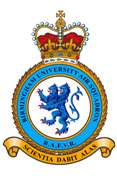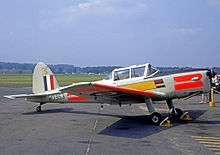University of Birmingham Air Squadron
The University of Birmingham Air Squadron, commonly known as UBAS, is a squadron within the Royal Air Force established in 1942. It is based at RAF Cosford, Shropshire, and flies a fleet of six Grob Tutors. In 2009 the squadron upgraded the aircraft to the Grob Tutor EA which has an advanced avionics suite. The Squadron has four Flights, A, B, C and D; each with a student Flight Commander who holds the rank of Acting Pilot Officer and a Deputy who holds the rank of Officer Cadet. UBAS is also the parent squadron of 8 Air Experience Flight, who jointly fly UBAS' Tutor fleet.
| University of Birmingham Air Squadron RAFVR | |
|---|---|
 | |
| Active | 1941-present |
| Role | Training, Recruiting |
| Part of | No. 6 Flying Training School |
| Garrison/HQ | RAF Cosford |
| Motto(s) | Scientia Dabit Alas (Latin: Knowledge Will Give Us Wings)[1] |
| Equipment | Grob Tutor T1 |
| Insignia | |
| Identification symbol | One blue, double headed lion rampant |
A Squadron Leader is the Commanding Officer, while UBAS also has several other Qualified Flying Instructors and a Ground Training Instructor. There are some seventy students on the squadron, which accepts members from the University of Birmingham, Birmingham City University, Aston University, Coventry University, Warwick University, Keele University, Wolverhampton University and Staffordshire University.[2]
Students volunteer to join UBAS at their university's Freshers' Fair and then undergo a selection process. If successful they are attested and join the Royal Air Force Volunteer Reserve. All Students are given the rank of Officer Cadet, and are issued with a uniform. UBAS activities include flight, sports, military and leadership training, adventurous training, charity and community work and a vibrant social scene.[3] The scope of UBAS, like other University Air Squadrons is to let young people experience life in the Royal Air Force and to develop their skills in the fields mentioned.[4]
History

Birmingham University Air Squadron was formed on 3 May 1941[5] and began its first undergraduate initial officer training course in October 1942. In October 1946 it began flying training at RAF Castle Bromwich on the DH Tiger Moth T Mk 2 aircraft.[6] The Squadron re-equipped with the DHC-1 Chipmunk T10 in July 1950 and was renamed the University of Birmingham Air Squadron (UBAS) on 15 October 1951.[7] In March 1958 UBAS was relocated to RAF Shawbury.[8] The Chipmunks served for 25 years until the SA Bulldog T1's replaced them in June 1975. UBAS moved "temporarily" to RAF Cosford in March 1978,[9] and it has remained based there ever since. The Bulldogs were retired in 2001 and were replaced with the Austrian-built Grob G-115E Tutor aircraft. In November 2009 the Grob 115E's were partly replaced with the higher specification Grob 115 EA.
Commanding officers
- Sqn Ldr Craig Finch 2019 - Present
- Sqn Ldr Ged Sheppeck 2015–2019
- Sqn Ldr Phil Atkinson 2013 - 2015
- (Acting) Sqn Ldr Ian Grogan 2012 - 2013
- Sqn Ldr Mark Richardson 2009 – 2012
- Sqn Ldr Chris Parkinson 2007 - 2009
- Sqn Ldr Laurie Dunn 2005 - 2007
- Sqn Ldr Ged Sheppeck 2003 - 2005
- Sqn Ldr Andy Baker 2000 - 2003
Flying
All of the cadets have the opportunity to participate in the flying syllabus for the University Air Squadrons.
Successful completion of the Core Syllabus qualifies the student pilot for the award of the Preliminary Flying Badge, or 'Budgie Wings' as they are sometimes called.
de Havilland Flying Trophy
UBAS Annually takes part in the de Havilland Flying Trophy, which is a flying competition that is undertaken between Birmingham, East Midlands, London, and Cambridge University air squadrons. The flying competitions comprises 4 events, practice force landings (PFL's), aerobatics, navigation, and a ground quiz. PFl's are undertaken by 3 students whereas the aerobatics and navigation are an individual event. The squadron that wins hosts the event the following year.
See also
- East of Scotland Universities Air Squadron
- Liverpool University Air Squadron
- Oxford University Air Squadron
- Southampton University Air Squadron
- Universities of Glasgow and Strathclyde Air Squadron
- University Royal Naval Unit, the Royal Navy equivalent
- Officers Training Corps, the British Army equivalent
- List of Royal Air Force aircraft squadrons
References
- Pine, L G (1983). A dictionary of mottoes. London: Routledge & Kegan Paul. p. 214. ISBN 0-7100-9339-X.
- Brew, Alec (1995). RAF Cosford in old photographs. Stroud: Alan Sutton Publishing. p. 51. ISBN 0-7509-0701-0.
- O'Brien, Lisa (5 May 2016). "Talented flyer trained in county". Shropshire Star (15752). p. 5.
- Dent, Stephen (2006). The Royal Air Force Handbook. London: Anova Books. p. 165. ISBN 9780851779522.
- Margiotta, Gerry (2003). "University Air Squadrons in WW II". The Royal Air Force Historical Society. Royal Air Force Historical Society (29A): 71. ISSN 1361-4231.
- "UBAS History". University of Birmingham Air Squadron. Royal Air Force. Retrieved 9 May 2016.
- Lake, Alan (1999). Flying Units of the RAF. Shrewsbury: Airlife. p. 314. ISBN 1-84037-086-6.
- Delve, Ken (2007). The military airfields of Britain, Wales and West Midlands : Cheshire, Hereford & Worcester, Northamptonshire, Shropshire, Staffordshire, Warwickshire, West Midlands and Wales (1 ed.). Ramsbury: Crowood. p. 271. ISBN 978-1-861269-17-1.
- Delve, Ken (2007). The military airfields of Britain - Wales and West Midlands. Marlborough: Crowood Press. p. 89. ISBN 978-1-861269-17-1.
